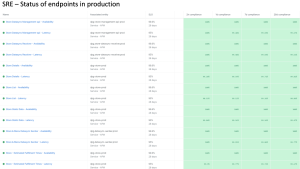DevOps pop quiz: What would you call the following scenario?
a.) DevOps feat
b.) DevOps fail
c.) Too early to tell whether it’s a feat or a fail
A company called Gamechanger Industries has an awesome idea for an application that will generate new, recurring revenue from its customer base and help the company meets its business goals. Gamechanger sets goals for the customer experience and optimizes the application to meet those goals. The efforts pay off, and after developing and launching a beta, the app is a hit, with customers downloading it in droves.
If you answered c, give yourself a pat on the back because you’re right—what may initially sound like a success can quickly turn into a disaster, especially considering something like this could easily happen afterward:
 Despite Gamechanger taking proactive measures to scale the infrastructure, the centralized database doesn’t scale at peak times, causing a bad experience for all those hundreds of thousands of users. Those users have little tolerance for the slowness, get frustrated, and don’t stick around.
Despite Gamechanger taking proactive measures to scale the infrastructure, the centralized database doesn’t scale at peak times, causing a bad experience for all those hundreds of thousands of users. Those users have little tolerance for the slowness, get frustrated, and don’t stick around.
To avoid ending up in situations like these, be sure to read our latest ebook, “DevOps Without Measurement Is a Fail,” which introduces what we believe are the five critical drivers of DevOps success, along with how and what to measure to achieve that success. In this post we’ll continue to take a look at how app performance can impact DevOps success and what type of metrics you should be tracking to make sure your DevOps efforts are paying off.
Watch out for performance bottlenecks
Datastores, including relational databases and newer NoSQL caches, can be critical components of an application architecture but are also very often performance bottlenecks. Visibility into the performance of these different datastores is helpful, but the real goal is understanding how database performance impacts app performance, and ultimately the end-user experience. Performance monitoring in this aspect is obviously important, but can also be difficult because many database issues don’t appear until there are a lot of users creating significant load on the overall application, and then it’s often too late.
Catching performance problems before they manifest (and only at scale) requires tracking and monitoring a number of database and application performance KPIs. Hopefully, your team is already focused on some or all of these KPIs:
- Uptime (availability)
- App response time
- Database response time
- % of transaction time spent in database
- Resource utilization
- Database query times
Want to understand how your DevOps efforts are impacting the customer experience, and ultimately your business success? Be sure to download our ebook about measuring DevOps for additional KPIs to monitor!
Les opinions exprimées sur ce blog sont celles de l'auteur et ne reflètent pas nécessairement celles de New Relic. Toutes les solutions proposées par l'auteur sont spécifiques à l'environnement et ne font pas partie des solutions commerciales ou du support proposés par New Relic. Veuillez nous rejoindre exclusivement sur l'Explorers Hub (discuss.newrelic.com) pour toute question et assistance concernant cet article de blog. Ce blog peut contenir des liens vers du contenu de sites tiers. En fournissant de tels liens, New Relic n'adopte, ne garantit, n'approuve ou n'approuve pas les informations, vues ou produits disponibles sur ces sites.



